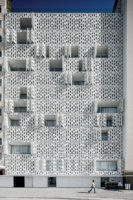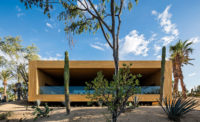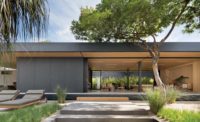When viewing the latest project in Rio de Janeiro by Brazilian architect Arthur Casas, it is best to bring your sea legs. The panoramic vista on exiting the elevator of the 14th-floor apartment, in a building overlooking Ipanema beach, gives one the sensation of floating on the stunning blue waters of the South Atlantic Ocean. Stepping into the spacious living area, you could easily be forgiven for thinking you have been granted access to a particularly luxurious suite on an ocean liner.
Additional Content:
Jump to credits & specifications
And these seaward views are only the start. With this complete redesign of a unit from a mid-1980s building, Casas has taken advantage of a rare opportunity in one of the world’s most topographically dramatic cities.
The Edificio Cap Ferrat soars above its neighbors thanks to its construction during an era of notoriously lax zoning regulations in Rio, which allowed developers to throw up taller buildings, even if they cast shadows on the city’s fabled beaches. This means the 5,600-square-foot apartments that occupy the upper reaches of the 17-story tower are possessed of extremely rare 360-degree views of Brazil’s stunning second city.
Its front-facing rooms follow the sweep of Ipanema west towards Leblon and the Two Brothers mountain, while off to the east is Arpoador Rock and, beyond it, the Sugar Loaf. And, across the tops of neighboring buildings, the rear-facing rooms look out toward Rodrigo de Freitas Lake, over which looms Corcovado Mountain with its immense Cristo Redentor (Christ the Redeemer) statue.
These privileged aspects have made Cap Ferrat’s apartments some of the most sought after and expensive in all Brazil. To best incorporate this embarrassment of visual riches, Casas demolished a warren of rooms. He also took advantage of the building’s recent decision to remove its beach-facing balconies, which were little used because of constant wind, to expand the internal floor space. Casas has left only the columns and elevator shafts of the original apartment. His new floor plan ensures the entire perimeter of the unit is now employed to provide ample light and magnificent views for all of the integrated living and dining space and five en-suite bedrooms. Even the kitchen, which in Rio is usually relegated to a poorly lit space in the bowels of apartments, has its own piece of prime real estate just behind the facade.
Circulation is provided by an internal L-shaped corridor that wraps around the centrally located elevator shafts and a hidden utility area. This connects the common areas with the sleeping accommodations. Illuminated by strip lighting recessed into the ceiling that hovers above a marble floor, this oak-paneled corridor stands in subdued contrast to the airy lightness of the rest of the residence.
The minimalist rooms have a restrained breeziness that only seek to complement rather than compete with the exterior vistas they frame. “We seek to incorporate the views outside into the apartment, and everything inside is directed out towards the views,” explains Casas. Not for him is the stuffy clutter of some traditional Rio residences, which often crowds out the city’s majestic views.
The clients, from Brazil’s mountainous interior, gave him free rein with the redesign, only emphasizing the importance to them of the ocean views. The generously proportioned living and dining areas have floor to ceiling windows which, thanks to the removal of the balconies, now directly overlook the sea. Travertine flooring recreates the visual sensation of the white sand below.
The impression of being still on the beach is further enhanced by the strategic use of furniture, the selection of which the clients entrusted to Casas. The standout items are a dramatic wood-sculpted Cará armchair by Hugo França and a trio of roughly finished coffee tables by Tora Brasil that could all be driftwood washed up by the ocean below. The mix of international and Brazilian pieces, some by Casas’ own studio, is set against his built-in furniture, such as the stone-clad sideboards at each end of the living and dining space, that emphasizes the interior’s horizontal line.
This large communal volume can be subdivided by a long sliding paneled door, hidden when unused and running on a discreet track. This can quickly isolate a more intimate space that, with the help of automated window blinds, dims the tropical light to create the home-theater environment requested by the clients.
The master bedroom, with its white plaster walls and white curtains and carpet, continues the dialogue with the beach that wraps around this corner suite. In the remaining four rooms, each with views of the city’s lush vegetation, there is a subtle shift toward wood textures, with fabric paneling in beige tones. These provide an organic sensuality that harmonizes with the tropical greenery outside.
With this latest project to complement his recent Emiliano Hotel on nearby Copacabana beach, Casas has confirmed his reputation as the São Paulo architect most in sympathy with Rio’s distinctive aesthetic, something he credits to being from out of town.
“When you are visiting somewhere else, you pay much more attention to the particulars of that place than when you are from it,” he says. With this blissful apartment that appears to have evolved from Ipanema’s sands below, Casas shows what a keen-eyed and admiring visitor he is to Brazil’s beach capital.
CreditsArchitect: Studio Arthur Casas Rua Itápolis, 818, Pacaembu, São Paulo, SP, Brazil +55 11 9357-4411
Personnel in architect's firm who should receive special credit: Arthur Casas (author), Alessandra Mattar, Victoria Chaves, Sabrina Aron (team)
Interior designer: Studio Arthur Casas
Consultants: Maneco Quinderé – light design, NOISE – automation
General contractor: IACL Interiores - Arq. Carlos Affonso Agapito da Veiga
Photographer: Filippo Bamberghi |
SpecificationsInterior Finishes Wall coverings: oak wood/ white carrara marble/ travertino navona/ painted Resilient flooring: travertino navona, oak wood, white carrara marble Special interior finishes unique to this project: White Carrara marble, on the floors and walls. Travertino Navona flooring on the living room.
Furnishings Office furniture: FK leather high back bucket seat by Jorgen Kastholm & Preben Fabricius, Casual Interiores Fixed seating: Chairs: Quem Será chairs by Arthur Casas, América, Micasa Cará armchair by Hugo França The Flag Halyard Chair by Hans J Wegner, Casual Interiores Brasiliana armchair by Jorge Zalszupin, Arquivo Contemporâneo Delfino armchair, Casual Interiores Paulistana armchair by Jorge Zalszupin, Arquivo Contemporâneo Presidencial armchair by Jorge Zalszupin, Arquivo Contemporâneo Benjamin armchair by Sergio Rodrigues, Way Designs;
Tables: Amorfa table by Arthur Casas, América, Micasa Wood center table, Tora Brasil Cigg table by Jader Almeida, Belcolore Pétalas table, Herança Cultural Mex center table by Piero Lissoni Warchawchik side table, Arquivo Contemporâneo
Upholstery:Aloe rug, Phenicia Chenille 786 rug, Nani Chinellato
Other furniture: Groundpiece sofa, Flexform Ribbon sofá by Paola Lenti, Casual Exteriores Big Mobile 3 arms luminaire by Andrew Neyer Floor lamp IC Lights F2, Casual Interiores Belly tablelamp by Arthur Casas, Studio Objeto Bauhaus luminaire; 1949 side table by Cassina Eddy table lamp, Lumini |













Post a comment to this article
Report Abusive Comment